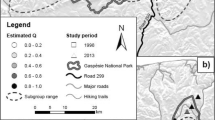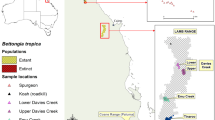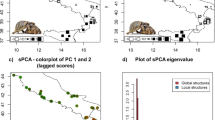Abstract
For conservation managers tasked with recovering threatened species, genetic structure can exacerbate the rate of loss of genetic diversity because alleles unique to a sub-population are more likely to be lost by the effects of random genetic drift than if a population is panmictic. Given that intensive management techniques commonly used to recover threatened species frequently involve movement of individuals within and between populations, managers need to be aware not only of pre-existing levels of genetic structure but also of the potential effects that intensive management might have on these patterns. The Mauritius parakeet (Psittacula echo) has been the subject of an intensive conservation programme, involving translocation and reintroduction that has recovered the population from less than 20 individuals in 1987 to approximately 500 in 2010. Analysis of genotype data derived from 18 microsatellite markers developed for this species reveals a clear signal of structure in the population before intensive management began, but which subsequently disappears following management intervention. This study illustrates the impacts that conservation management can have on the genetic structure of an island endemic population and demonstrates how translocations or reintroductions can benefit populations of endangered species by reducing the risk of loss of genetic diversity.




Similar content being viewed by others
References
Acevedo-Whitehouse K, Gulland F, Greig D, Amos W (2003) Disease susceptibility in California sea lions. Nature 422:35–36
Armstrong DP, Ewen JG (2001) Assessing the value of follow-up translocations: a case study using New Zealand robins. Biol Conserv 101:239–247
Armstrong DP, Ewen JG (2002) Dynamics and viability of a New Zealand robin population reintroduced to regenerating fragmented habitat. Conserv Biol 16:1074–1085
Beier P, Noss RF (1998) Do habitat corridors provide connectivity? Conserv Biol 12:1241–1252
Bouzat JL (2001) The population genetic structure of the Greater Rhea (Rhea americana) in an agricultural landscape. Biol Conserv 99:277–284
Caizergues A, Rätti O, Helle P, Rotelli L, Ellison L, Rasplus J-Y (2003) Population genetic structure of male black grouse (Tetrao tetrix L.) in fragmented vs. continuous landscapes. Mol Ecol 12:2297–2305
Cheke AS, Hume J (2008) Lost land of the Dodo. An ecological history of Mauritius, Reunion & Rodrigues. T & AD Poyser, London
Corander J, Marttinen P (2006) Bayesian identification of admixture events using multilocus molecular markers. Mol Ecol 15:2833–2843
Corander J, Waldmann P, Sillanpaa MJ (2003) Bayesian analysis of genetic differentiation between populations. Genetics 163:367–374
Corander J, Marttinen P, Siren J, Tang J (2008) Enhanced Bayesian modelling in BAPS software for learning genetic structures of populations. BMC Bioinformatics 9:539
Debinski DM, Holt RD (2000) A survey and overview of habitat fragmentation experiments. Conserv Biol 14:342–355
Duffy K (1993) Echo parakeet project-Progress report August 1992–April 1993. Mauritian Wildlife Foundation, Vacoas
Evanno G, Regnaut S, Goudet J (2005) Detecting the number of clusters of individuals using the software STRUCTURE: a simulation study. Mol Ecol 14:2611–2620
Fahrig L (2001) How much habitat is enough? Biol Conserv 100:65–74
Frankel OH, Soule ME (1981) Conservation and evolution. Cambridge University Press, Cambridge
Frankham R, Ballou JD, Briscoe DA (2010) Introduction to conservation genetics, 2nd edn. Cambridge University Press, Cambridge
Frantz AC, Cellina S, Krier A, Schley L, Burke T (2009) Using spatial Bayesian methods to determine the genetic structure of a continuously distributed population: clusters or isolation by distance? J Appl Ecol 46:493–505
Galbusera P, Githiru M, Lens L, Matthysen E (2004) Genetic equilibrium despite habitat fragmentation in an Afrotropical bird. Mol Ecol 13:1409–1421
Goudet J (1995) FSTAT (Version 1.2): a computer programme to calculate F-Statistics. J Hered 86:485–486
Haig SM, Bowman R, Mullins TD (1996) Population structure of red-cockaded woodpeckers in south Florida: RAPDs revisited. Mol Ecol 5:725–734
Hartl DL, Clark AG (1997) Principles of Population Genetics. Sinauer Associates, Sunderland
Jones CG (1987) The larger land-birds of Mauritius. In: Diamond AW (ed) Studies of Mascarene Island birds. British Ornithologists Union and Cambridge University Press, Cambridge, pp 208–301
Jones CG, Duffy K (1993) Conservation management of the echo parakeet. Dodo 29:126–148
Jones CG, Swinnerton KJ, Thorsen M, Greenwood A (1998) The biology and conservation of the echo parakeet Psittacula eques of Mauritius. In: Proceedings of IV International Parrot Convention, Tenerife, pp 110–123
Kenta T, Gratten J, Haigh NS, Hinten GN, Slate J, Butlin RK, Burke T (2008) Multiplex SNP-SCALE: a cost-effective medium-throughput single nucleotide polymorphism genotyping method. Mol Ecol Resour 8:1230–1238
Latch E, Dharmarajan G, Glaubitz J, Rhodes O (2006) Relative performance of Bayesian clustering software for inferring population substructure and individual assignment at low levels of population differentiation. Conserv Genet 7:295–302
Lindsay DL, Barr KR, Lance RF, Tweddale SA, Hayden TJ, Leberg PL (2008) Habitat fragmentation and genetic diversity of an endangered, migratory songbird, the golden-cheeked warbler (Dendroica chrysoparia). Mol Ecol 17:2122–2133
Lovegrove TG, Nieuwland AB, Green S (1995) Interim report on the echo parakeet conservation project, February 1995. Mauritian Wildlife Foundation, Vacoas
Marshall TC, Slate J, Kruuk LEB, Pemberton JM (1998) Statistical confidence for likelihood-based paternity inference in natural populations. Mol Ecol 7:639–655
Nicholls JA, Double MC, Rowell DM, Magrath RD (2000) The evolution of cooperative and pair breeding in thornbills Acanthiza (Pardalotidae). J Avian Biol 31:165–176
Owens IPF, Bennett PM (2000) Ecological basis of extinction risk in birds: Habitat loss versus human persecution and introduced predators. Proc Natl Acad Sci USA 97:12144–12148
Pritchard J, Stephens M, Donnelly P (2000) Inference of population structure using multilocus genotype data. Genetics 155:945–959
Raisin C, Dawson DA, Greenwood AG, Jones CG, Groombridge JJ (2009) Characterization of Mauritius parakeet (Psittacula eques) microsatellite loci and their cross-utility in other parrots (Psittacidae, Aves). Mol Ecol Resour 9:1231–1235
Raymond M, Rousset F (1995) GENEPOP (Version 1.2): population genetics software for exact tests and ecumenicism. J Hered 86:248–249
Rice WR (1989) Analysing tables of statistical tests. Evolution 43:223–225
Richards H, Chowrimootoo A, Garrett M, Bednarczuk E, Smith D, Tollington S, Skinner A (2010) Management of the echo parakeet in the wild 2009/10. Mauritian Wildlife Foundation, Vacoas
Ritchie BW, Niagro FD, Lukert PD, Latimer KS, Steffens WL, Pritchard N (1989) A review of psittacine beak and feather disease: characteristics of the PBFD virus. J Assoc Avian Vet 3:143–149
Rousset F (1997) Genetic differentiation and estimation of gene flow from F-Statistics under isolation by distance. Genetics 145:1219–1228
Rousset F (2000) Genetic differentiation between individuals. J Evol Biol 13:58–62
Seddon PJ, Armstrong DP, Maloney RF (2007) Developing the science of reintroduction biology. Conserv Biol 21:303–312
Segelbacher G, Höglund J, Storch I (2003) From connectivity to isolation: genetic consequences of population fragmentation in capercaillie across Europe. Mol Ecol 12:1773–1780
Webley LS, Zenger KR, Hall GP, Cooper DW (2007) Genetic structure of introduced European fallow deer (Dama dama dama) in Tasmania, Australia. Eur J Wildl Res 53:40–46
Acknowledgments
This work was funded by a NERC PhD studentship award to JG with CASE partner Wildlife Vets International. The laboratory work was performed at the NERC Biomolecular Analysis Facility at the University of Sheffield and we would particularly like to thank Deborah Dawson and Andy Krupa for their assistance. We also thank all the staff of the National Parks and Conservation Service of the Government of Mauritius and the Mauritian Wildlife Foundation for support with fieldwork.
Author information
Authors and Affiliations
Corresponding author
Electronic supplementary material
Below is the link to the electronic supplementary material.
Rights and permissions
About this article
Cite this article
Raisin, C., Frantz, A.C., Kundu, S. et al. Genetic consequences of intensive conservation management for the Mauritius parakeet. Conserv Genet 13, 707–715 (2012). https://doi.org/10.1007/s10592-012-0319-0
Received:
Accepted:
Published:
Issue Date:
DOI: https://doi.org/10.1007/s10592-012-0319-0




